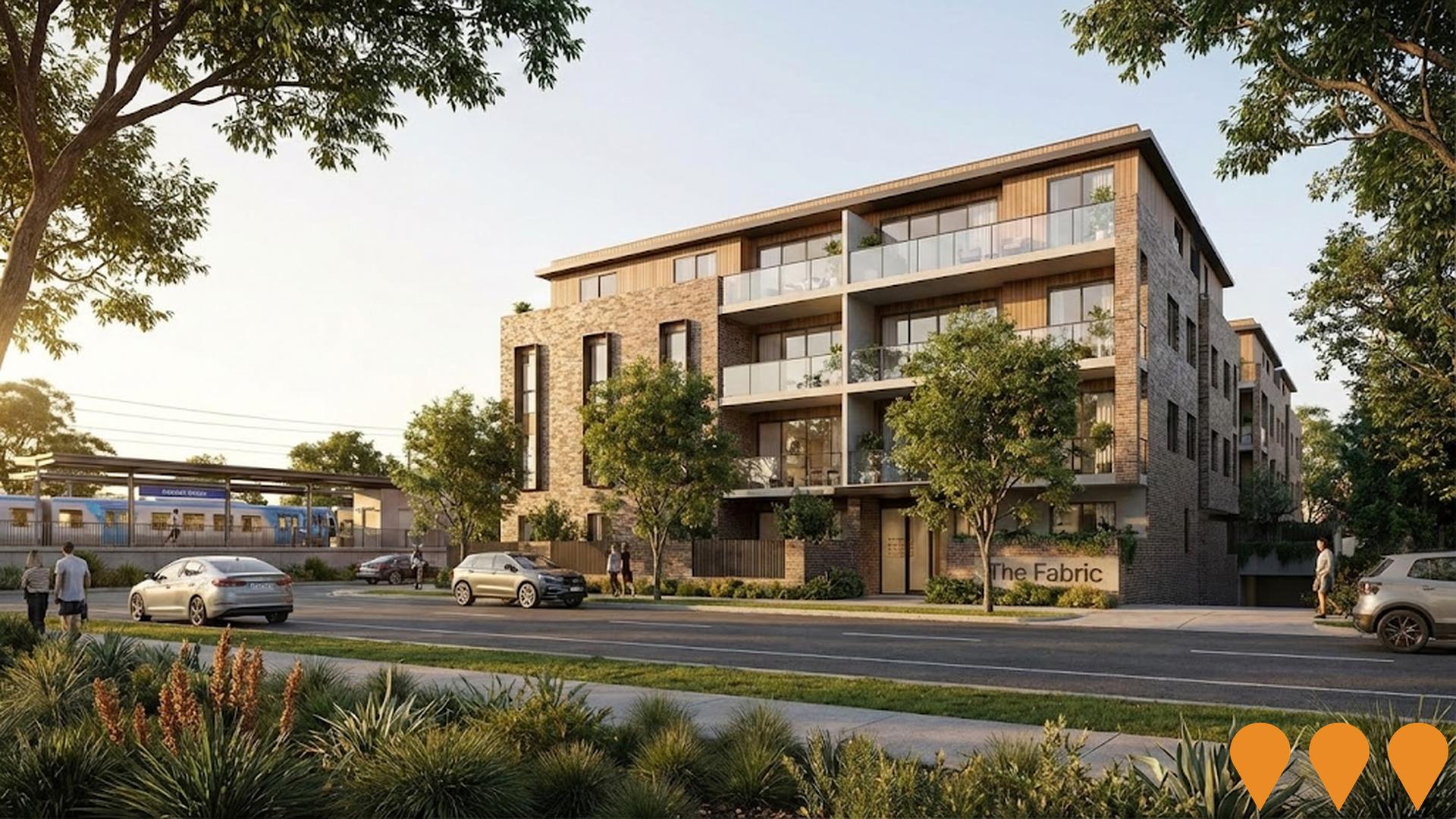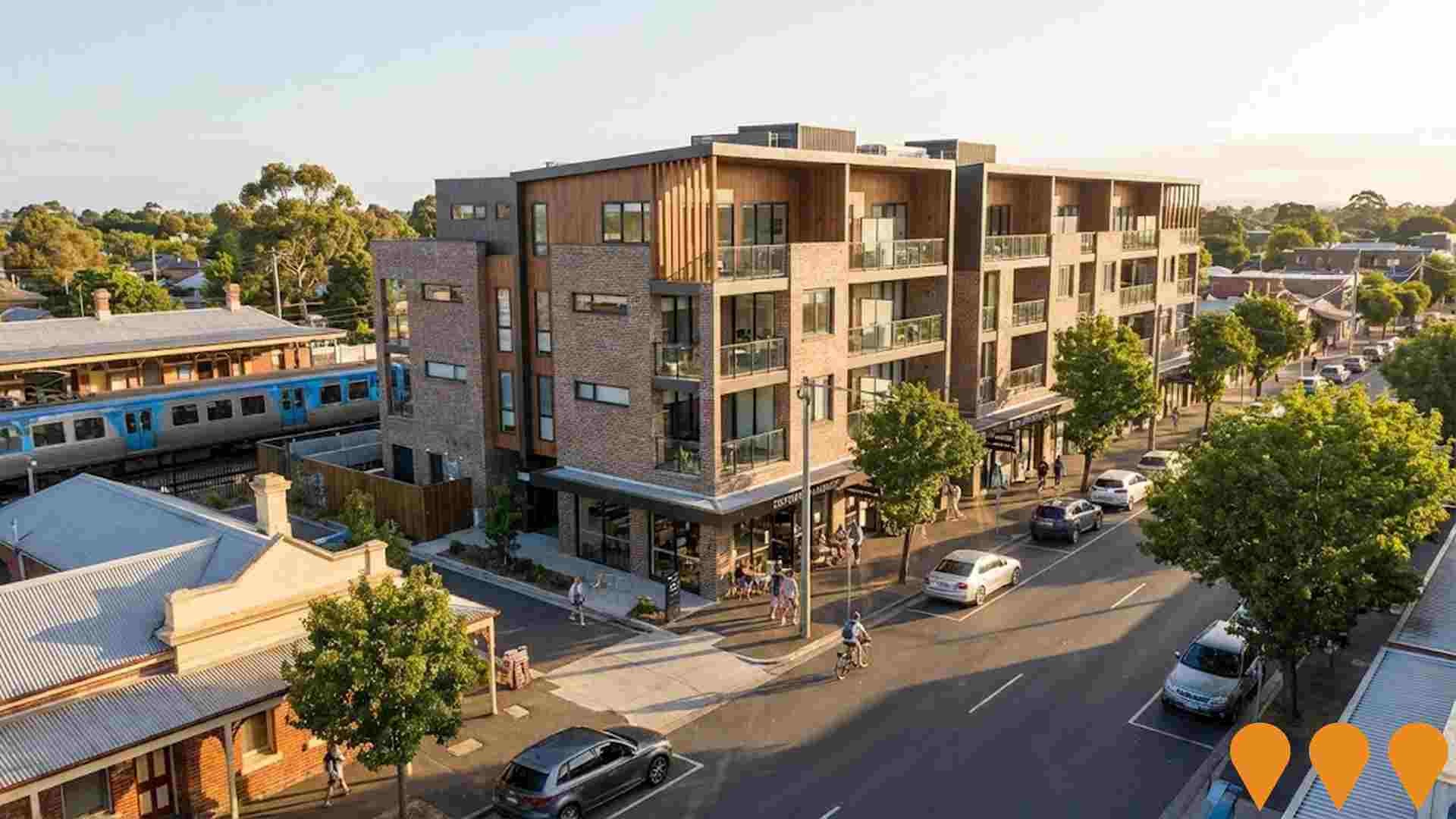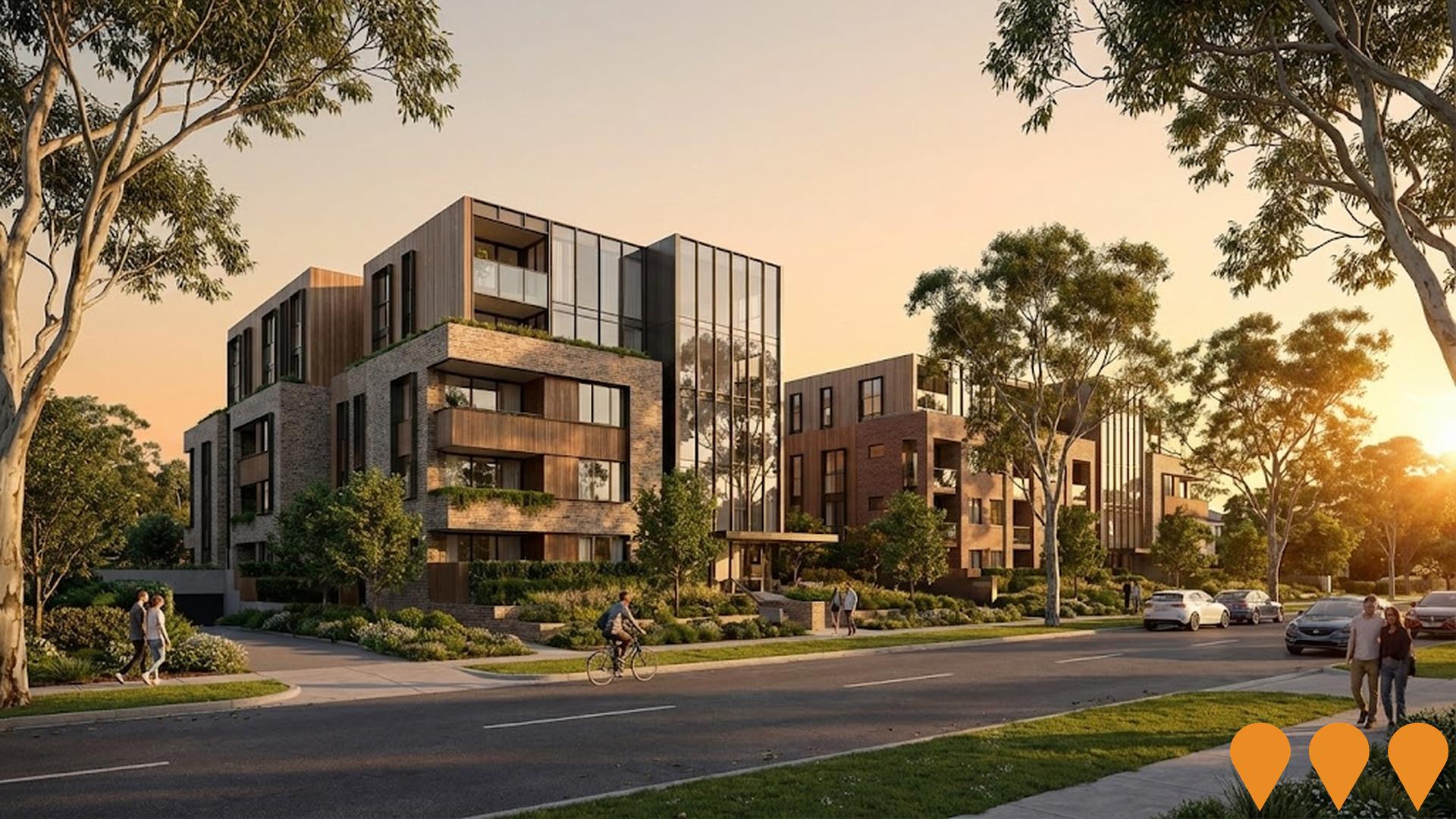Chart Color Schemes
est. as @ -- *
ABS ERP | -- people | --
2021 Census | -- people
Sales Activity
Curious about local property values? Filter the chart to assess the volume and appreciation (including resales) trends and regional comparisons, or scroll to the map below view this information at an individual property level.
Find a Recent Sale
Sales Detail
Population
Population growth drivers in Alphington - Fairfield are strong compared to national averages based on AreaSearch's ranking of recent, and medium to long-term trends
Alphington - Fairfield's population is approximately 9,722 as of Aug 2025. This figure represents an increase of 728 people since the 2021 Census, which recorded a population of 8,994. The growth was inferred from ABS estimates and new addresses validated between June 2024 and the Census date. This results in a population density of 3,364 persons per square kilometer, placing Alphington - Fairfield in the upper quartile nationally according to AreaSearch's assessments. The area's 8.1% growth since 2021 exceeds the SA3 region's 6.5%, indicating it as a growth leader. Overseas migration contributed approximately 76.2% of overall population gains during recent periods.
AreaSearch uses ABS/Geoscience Australia projections for each SA2 area, released in 2024 with a base year of 2022. For areas not covered by this data, AreaSearch employs VIC State Government's Regional/LGA projections from 2023, adjusted using weighted aggregation methods. Growth rates by age group are applied across all areas for years 2032 to 2041. Future trends predict exceptional growth, placing Alphington - Fairfield in the top 10 percent of Australian statistical areas. By 2041, the area is expected to grow by 4,308 persons based on current population numbers, reflecting a total increase of 44.0% over 17 years.
Frequently Asked Questions - Population
Development
AreaSearch analysis of residential development drivers sees Alphington - Fairfield recording a relatively average level of approval activity when compared to local markets analysed countrywide
Alphington-Fairfield has seen approximately 41 new homes approved annually. Over the past five financial years, from FY21 to FY25, around 206 homes were approved, with an additional 9 approved so far in FY26. On average, about 1.1 people moved to the area for each dwelling built over these five years, indicating a balanced supply and demand creating stable market conditions. However, this has accelerated recently, with 8.1 people moving per dwelling over the past two financial years, suggesting increased demand and tightening supply.
The average construction value of development projects is around $962,000, reflecting a focus on the premium market with high-end developments. This year alone, $13.8 million in commercial approvals have been registered, indicating steady commercial investment activity. Compared to Greater Melbourne, Alphington-Fairfield records elevated construction levels, 28.0% above the regional average per person over the past five years, supporting good buyer choice and existing property values. However, building activity has slowed in recent years.
New building activity shows a trend towards denser development, with 42.0% detached houses and 58.0% medium and high-density housing, providing accessible entry options for downsizers, investors, and entry-level buyers. With around 318 people per dwelling approval, Alphington-Fairfield demonstrates a developing market. Looking ahead, the area is expected to grow by approximately 4,274 residents through to 2041. If current development rates continue, housing supply may struggle to match population growth, potentially heightening buyer competition and supporting price increases.
Frequently Asked Questions - Development
Infrastructure
Alphington - Fairfield has moderate levels of nearby infrastructure activity, ranking in the top 50% nationally
Changes to local infrastructure significantly influence an area's performance. AreaSearch has identified 17 projects likely impacting the area. Notable projects include Alphington Village (Time & Place), Fairfield Station Precinct Redevelopment, Paper House Alphington, and Samma Place, Ivanhoe. The following list details those most relevant.
Professional plan users can use the search below to filter and access additional projects.
INFRASTRUCTURE SEARCH
 Denotes AI-based impression for illustrative purposes only, not to be taken as definitive under any circumstances. Please follow links and conduct other investigations from the project's source for actual imagery. Developers and project owners wishing us to use original imagery please Contact Us and we will do so.
Denotes AI-based impression for illustrative purposes only, not to be taken as definitive under any circumstances. Please follow links and conduct other investigations from the project's source for actual imagery. Developers and project owners wishing us to use original imagery please Contact Us and we will do so.
Frequently Asked Questions - Infrastructure
YarraBend
16.5-hectare masterplanned mixed-use precinct on the former Amcor paper mill site in Alphington. Delivering approximately 2,500 residences (apartments, townhouses and riverfront homes), 15,000 sqm of retail and commercial space, wellness facilities, extensive parkland and public open space along the Yarra River. The Bend retail and dining precinct is now open and trading (including Decca by Adam D'Sylva, Zero95, Meno Zero and wellness operators). Multiple residential stages are complete and occupied, with construction continuing on later stages.

Alphington Village (Time & Place)
Major mixed-use development on former Amcor Paper Mill site featuring 632 build-to-rent apartments, 150 affordable housing units, 25,000sqm retail/commercial space including Coles supermarket, childcare centre, community facilities, and village square. Six towers ranging 5-14 levels with extensive amenities.
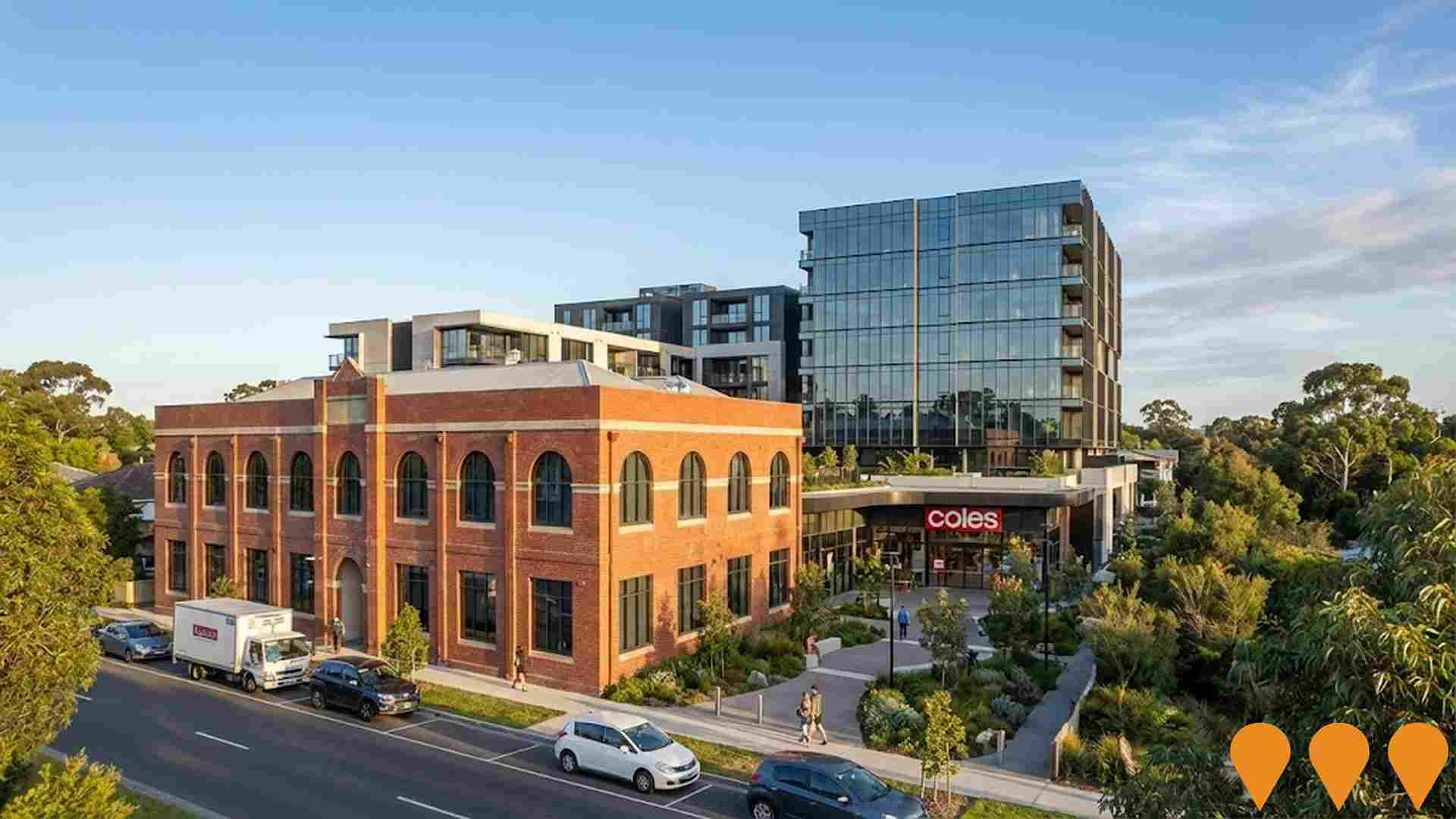
Fairfield Station Precinct Redevelopment
Major transformation of Fairfield Station as part of the Level Crossing Removal Project, including a new elevated station, 450-space multi-deck car park, upgraded forecourt, new public plaza, and improved pedestrian and cycling connections.

The Mills Alphington
A proposed mixed-use precinct on the former Alphington Paper Mill site featuring up to 1,000 apartments, retail spaces, and public open space, designed by Rothelowman and developed by Cedar Woods.
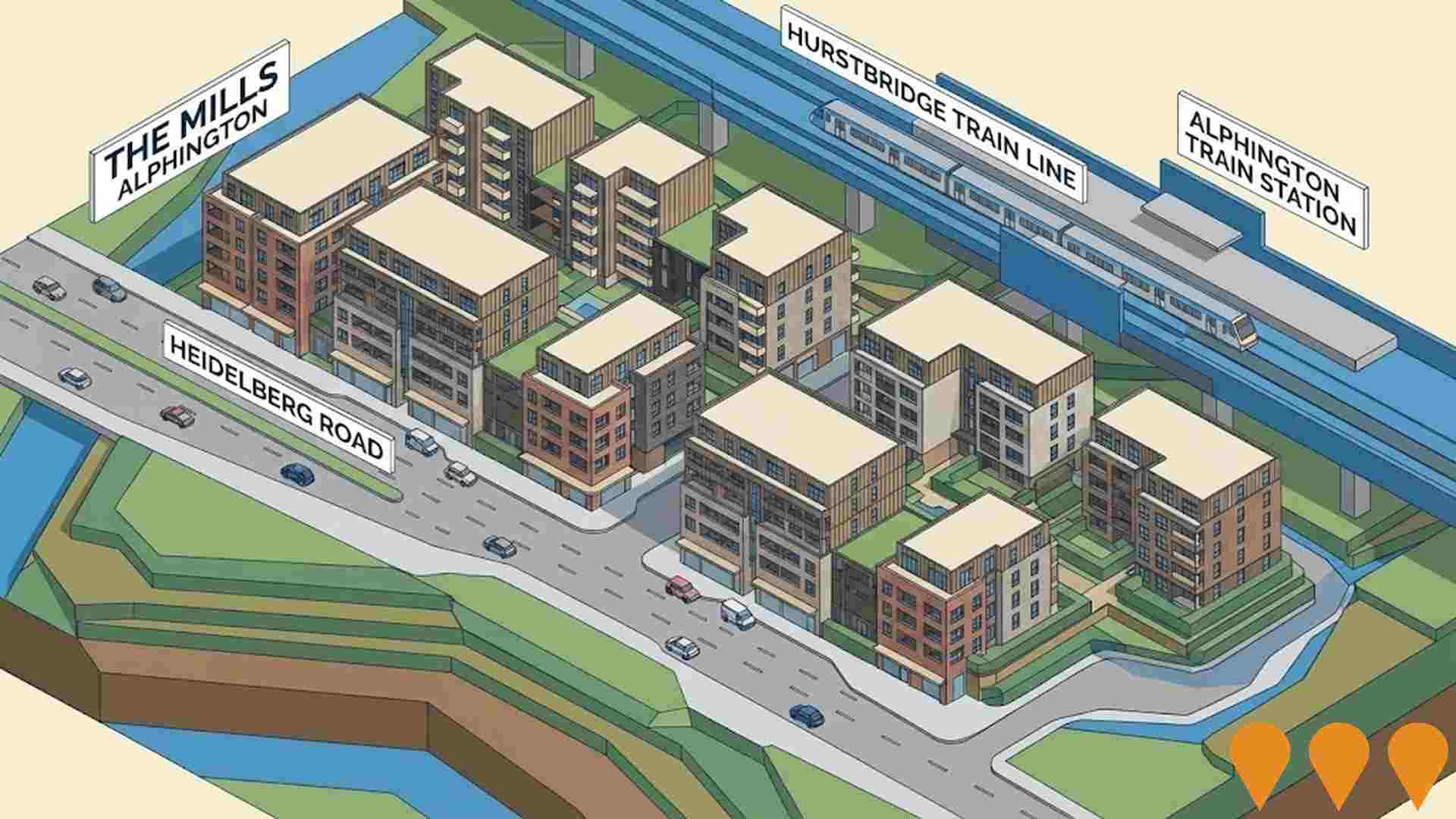
Alphington Park Estate
A masterplanned residential community on the former Amcor paper mill site featuring townhouses, apartments, and parkland, developed by Glenvill in partnership with YarraBend.
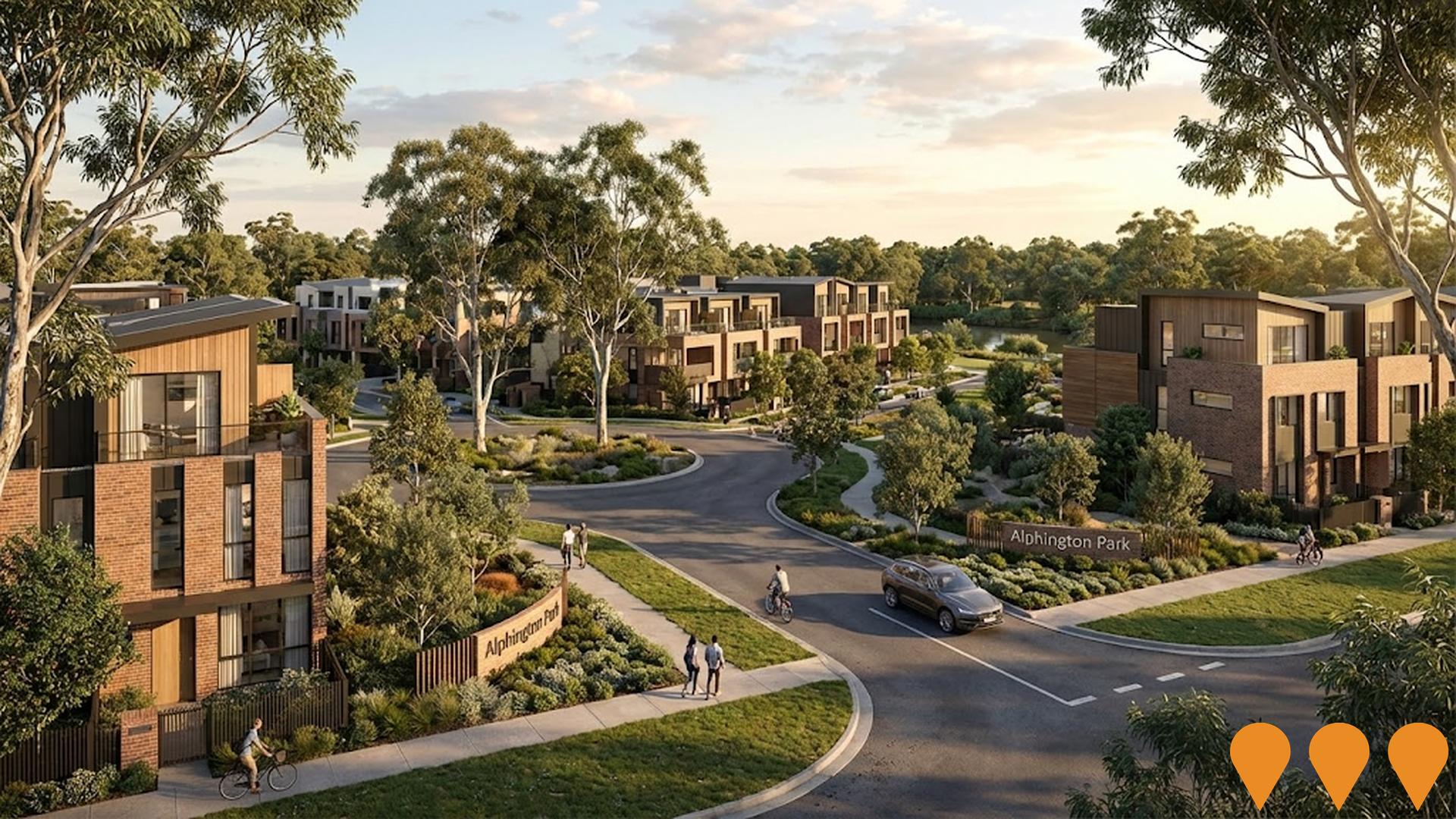
Paper House Alphington
A premium boutique residential development of 79 architect-designed apartments and townhouses within the YarraBend masterplan, featuring heritage mill facade retention and riverfront parkland.
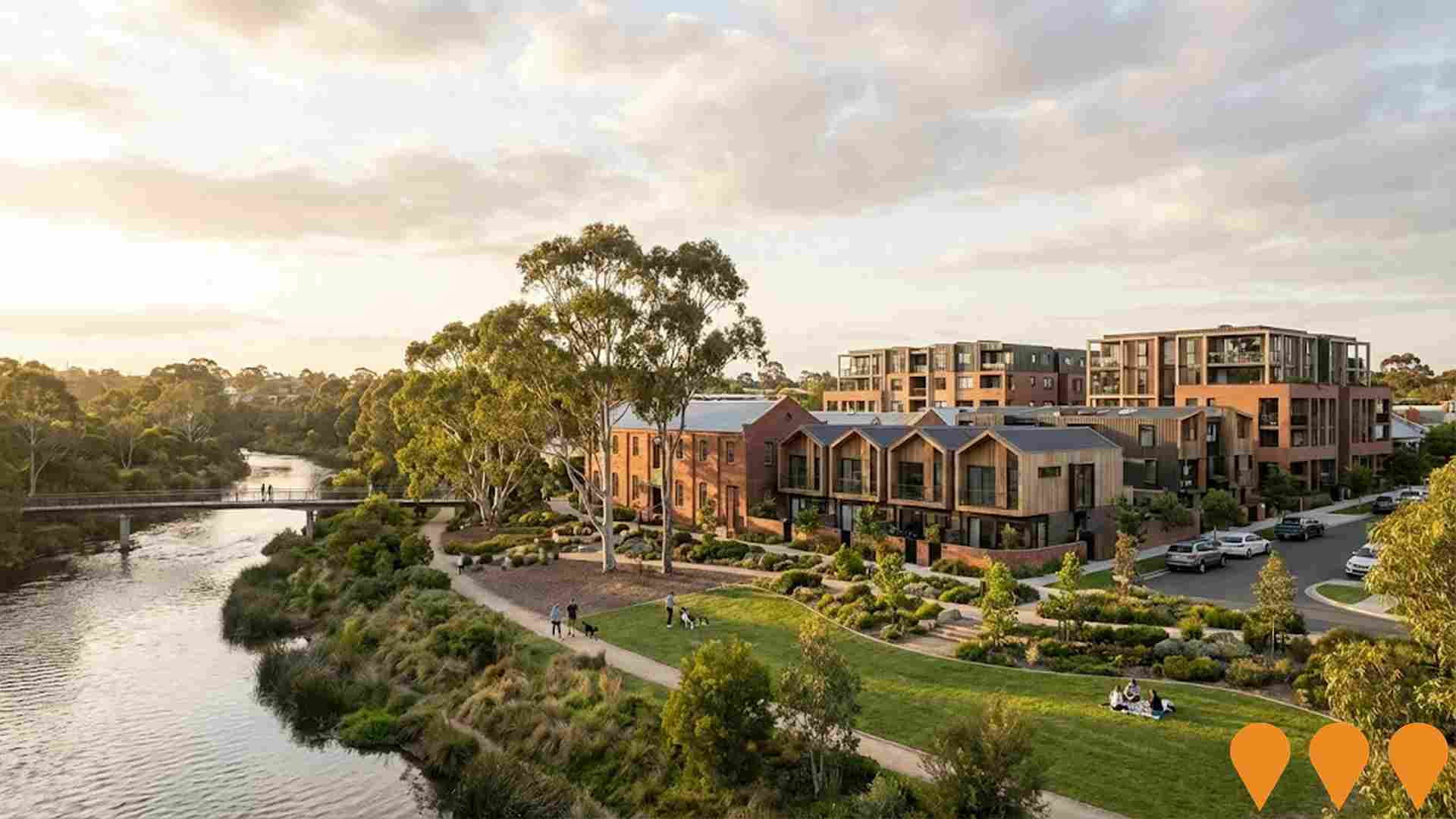
Nightingale 2.0
Sustainable 5-storey mixed-use development at 72A Station Street featuring 20 apartments (4 one-bedroom, 12 two-bedroom, 4 three-bedroom) and 3 retail tenancies. Zero car parking, 8-star energy rating, 100% renewable energy, no fossil fuels. Architect-led Nightingale Model project by Six Degrees Architects.

Samma Place, Ivanhoe
Four-building mixed-use precinct delivering around 491 apartments with ground-floor retail and office space at 87-131 Bell Street. Stage 1 (Linden) has commenced occupation, with remaining stages progressing under Samma Property Group.
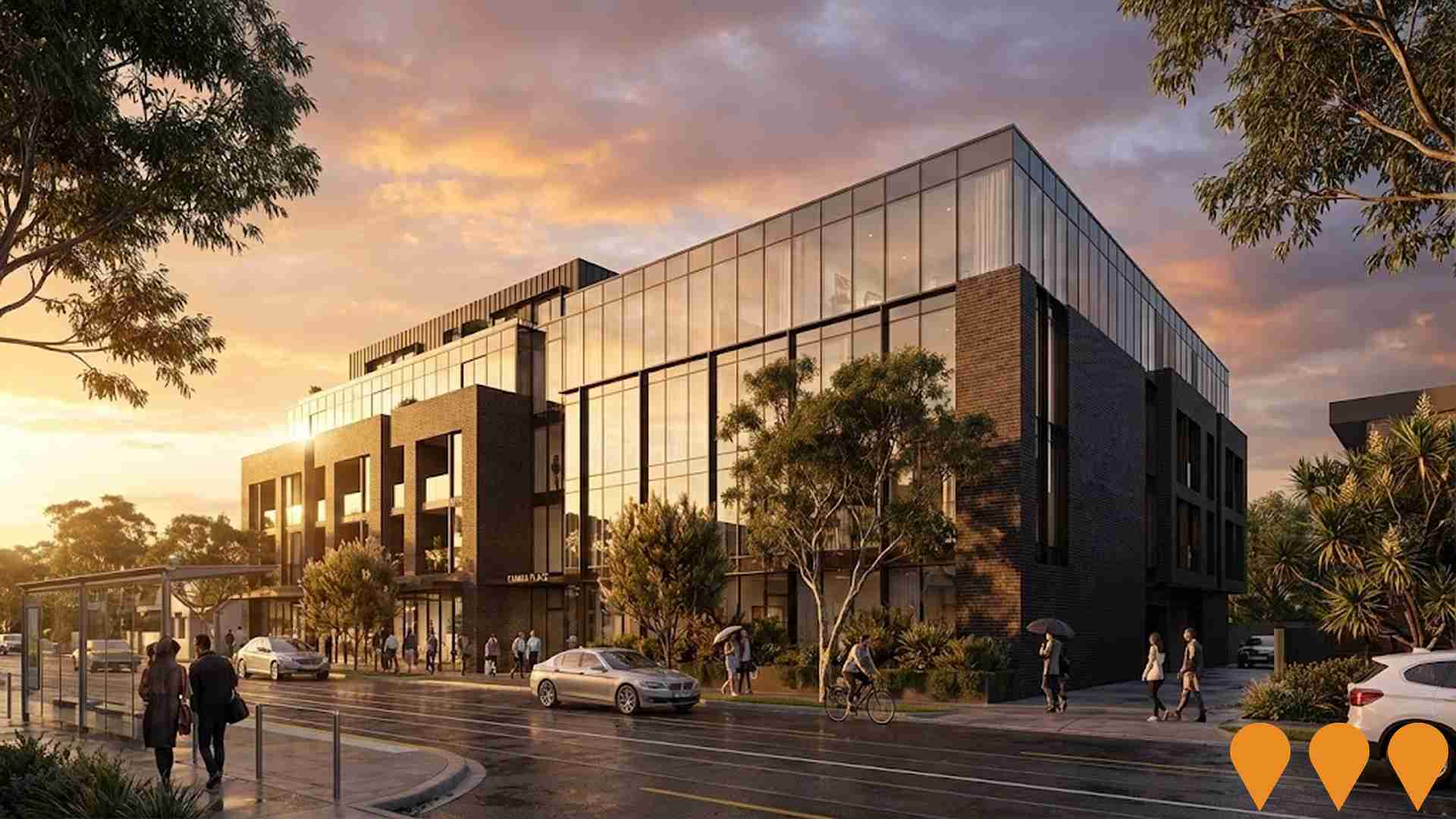
Employment
Employment performance in Alphington - Fairfield has been broadly consistent with national averages
Alphington-Fairfield has a highly educated workforce with strong representation in professional services. Its unemployment rate was 4.7% as of June 2025, aligning with Greater Melbourne's rate of 4.6%.
Workforce participation was higher at 71.2%, compared to Greater Melbourne's 64.1%. Key employment industries included health care & social assistance, professional & technical services, and education & training. The area had a significant specialization in professional & technical services, with an employment share 1.4 times the regional level. Conversely, construction showed lower representation at 5.5% compared to the regional average of 9.7%.
While local employment opportunities exist, many residents commute elsewhere for work based on Census data. Between June 2024 and June 2025, employment increased by 7.0%, while labour force grew by 7.1%, with unemployment remaining essentially unchanged. In contrast, Greater Melbourne experienced employment growth of 3.5% and labour force growth of 4.0%, with a 0.5 percentage point rise in unemployment. Jobs and Skills Australia's national employment forecasts from May 2025 project national employment growth of 6.6% over five years and 13.7% over ten years, varying significantly by industry sector. Applying these projections to Alphington-Fairfield's employment mix suggests local growth of approximately 7.3% over five years and 14.8% over ten years, though this is a simple weighted extrapolation for illustrative purposes only and does not account for localized population projections.
Frequently Asked Questions - Employment
Income
Income metrics indicate excellent economic conditions, with the area achieving higher performance than 75% of national locations assessed by AreaSearch
AreaSearch aggregated ATO data shows Alphington - Fairfield had a median taxpayer income of $67,612 and an average income of $100,763 in financial year 2022. Nationally, these figures are exceptionally high, compared to Greater Melbourne's median of $54,892 and average of $73,761. By September 2025, estimates suggest the median income will be approximately $75,834 and the average $113,016, based on a 12.16% Wage Price Index growth since financial year 2022. According to 2021 Census figures, incomes in Alphington - Fairfield rank highly nationally, between the 73rd and 86th percentiles for household, family, and personal incomes. The $1,500 - 2,999 income bracket dominates with 26.3% of residents (2,556 people), similar to broader regional trends at 32.8%. Economic strength is evident with 36.7% of households earning high weekly incomes exceeding $3,000, supporting elevated consumer spending. Housing accounts for 14.2% of income, and residents rank within the 75th percentile for disposable income. The area's SEIFA income ranking places it in the 9th decile.
Frequently Asked Questions - Income
Housing
Alphington - Fairfield displays a diverse mix of dwelling types, with above-average rates of outright home ownership
Alphington-Fairfield's dwelling structure, as per the latest Census, comprised 51.9% houses and 48.1% other dwellings (semi-detached, apartments, 'other' dwellings). This compares to Melbourne metro's 50.4% houses and 49.6% other dwellings. Home ownership in Alphington-Fairfield stood at 31.5%, with mortgaged dwellings at 30.2% and rented ones at 38.3%. The median monthly mortgage repayment was $2,200, below Melbourne metro's average of $2,300. Median weekly rent in the area was $381, compared to Melbourne metro's $421. Nationally, Alphington-Fairfield's mortgage repayments were higher at $2,200 versus Australia's average of $1,863, while rents were $381 against the national figure of $375.
Frequently Asked Questions - Housing
Household Composition
Alphington - Fairfield features high concentrations of group households and lone person households, with a fairly typical median household size
Family households constitute 60.5% of all households, including 28.8% couples with children, 23.2% couples without children, and 7.6% single parent families. Non-family households comprise the remaining 39.5%, with lone person households at 33.5% and group households making up 5.9%. The median household size is 2.3 people, which aligns with the Greater Melbourne average.
Frequently Asked Questions - Households
Local Schools & Education
Alphington - Fairfield shows strong educational performance, ranking in the upper quartile nationally when assessed across multiple qualification and achievement indicators
Educational attainment in Alphington-Fairfield is notably high, with 54.8% of residents aged 15+ holding university qualifications, compared to the national average of 30.4% and the Victorian average of 33.4%. Bachelor degrees are the most common at 31.7%, followed by postgraduate qualifications (15.9%) and graduate diplomas (7.2%). Vocational pathways account for 17.9% of qualifications among those aged 15+, with advanced diplomas making up 8.4% and certificates 9.5%. Educational participation is high, with 29.8% of residents currently enrolled in formal education, including 9.1% in tertiary, 8.0% in primary, and 6.8% in secondary education.
Fairfield Primary School and St Anthony's School serve the area, collectively educating 693 students. These schools focus on primary education, with ICSEA scores indicating significant socio-educational advantages (1148). Secondary options are available nearby due to limited local school capacity (7.1 places per 100 residents vs regional average of 22.6), leading many families to travel for schooling.
Frequently Asked Questions - Education
Schools Detail
Nearby Services & Amenities
Transport
Transport servicing is high compared to other areas nationally based on assessment of service frequency, route connectivity and accessibility
The analysis of public transport in Alphington-Fairfield shows that there are currently 60 active transport stops operating. These stops offer a mix of train and bus services. There are 13 individual routes servicing these stops, which collectively provide 6,480 weekly passenger trips.
The accessibility of transport is rated as excellent, with residents typically located just 131 meters from the nearest transport stop. On average, there are 925 trips per day across all routes, equating to approximately 108 weekly trips per individual stop.
Frequently Asked Questions - Transport
Transport Stops Detail
Health
The level of general health in Alphington - Fairfield is notably higher than the national average with both young and old age cohorts seeing low prevalence of common health conditions
Alphington-Fairfield shows superior health outcomes for both young and elderly populations, with low prevalence rates for common conditions. The private health cover rate is notably high at approximately 72% of the total population (6,970 people), compared to Greater Melbourne's 66.6%. Nationally, this figure stands at 55.3%.
Mental health issues and asthma are the most prevalent medical conditions in the area, affecting 10.3% and 8.0% of residents respectively. Notably, 70.7% of residents report no medical ailments, compared to Greater Melbourne's 69.1%. The area has a higher proportion of seniors aged 65 and over at 14.9% (1,446 people). Health outcomes among seniors are commendable, closely mirroring the general population's health profile.
Frequently Asked Questions - Health
Cultural Diversity
Alphington - Fairfield was found to be more culturally diverse than the vast majority of local markets in Australia, upon assessment of a range of language and cultural background related metrics
Alphington-Fairfield, surveyed from July 2016 to June 2021, had a higher cultural diversity than most local areas with 23.3% of its population born overseas and 19.9% speaking languages other than English at home. Christianity was the dominant religion in Alphington-Fairfield, comprising 37.1% of the population. Notably, Judaism was overrepresented at 0.3%, compared to Greater Melbourne's 0.5%.
Top ancestry groups were English (23.2%), Australian (20.3%), and Irish (10.9%). Greek (5.6%) and Italian (7.4%) were notably present, matching regional percentages, while Macedonian was slightly higher at 0.9% compared to the region's 0.9%.
Frequently Asked Questions - Diversity
Age
Alphington - Fairfield's population is slightly younger than the national pattern
The median age in Alphington-Fairfield is 38 years, close to Greater Melbourne's average of 37 and equivalent to Australia's median of 38. Compared to Greater Melbourne, Alphington-Fairfield has a higher proportion of residents aged 55-64 (12.3%) but fewer residents aged 5-14 (9.7%). Between the 2016 and 2021 censuses, the population aged 75-84 increased from 3.9% to 4.6%. Conversely, the 45-54 age group decreased from 14.4% to 13.2%, and the 5-14 age group dropped from 10.8% to 9.7%. By 2041, Alphington-Fairfield's age composition is expected to shift significantly, with the 45-54 age group projected to grow by 55% (701 people), reaching 1,982 from 1,280.
